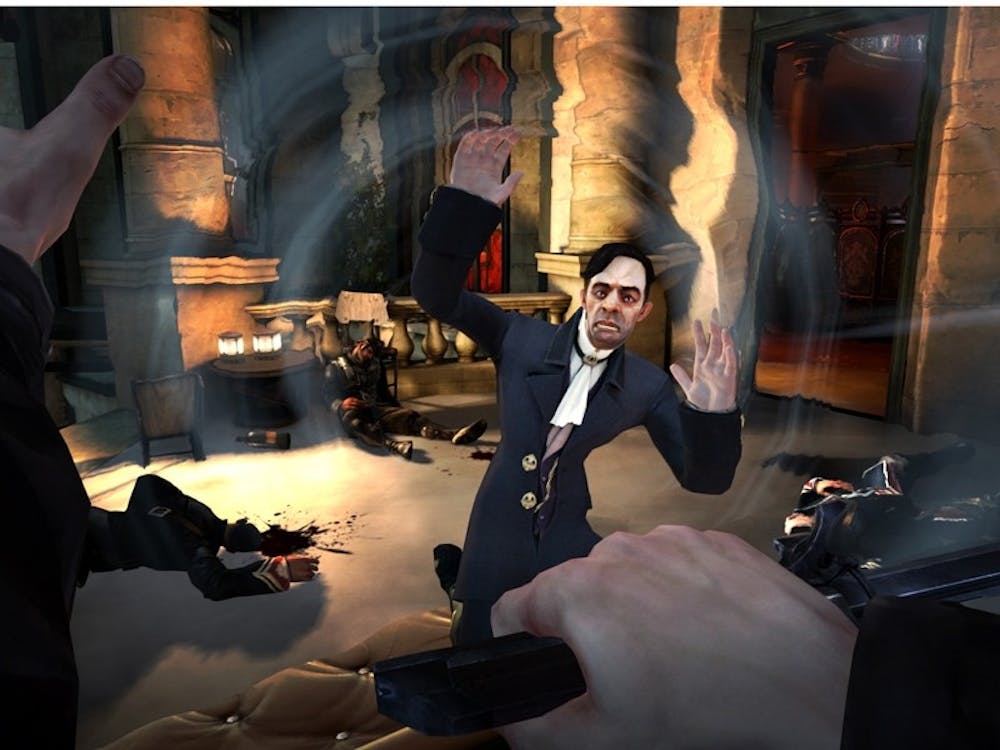‘Dishonored’ wastes stellar cast, breathtaking art on lackluster narrative
Don’t be fooled by “Dishonored’s” warm, watercolor art style and cartoonish character designs; the world in which the city of Dunwall resides is a corrupt and dystopic one, to be sure.
Here, whales are slaughtered en masse for their precious oil and aristocrats call hits on their own brothers. Plague-ridden rats infest cobblestone paved streets while a totalitarian government squawks orders at its citizens over city-wide PA systems. Dunwall, appropriately brutal, is as good a place as any to set a stealth-action game wherein the player takes control of a masked assassin bent on taking revenge.
At its onset, the game sets up a rather flimsy and predictable narrative about the protagonist, Corvo, being framed for the Empress of Dunwall’s murder, but this all matters very little. It is, rather, a thin premise to thrust Corvo into sneaking around in the shadows, collapsible ninja blade and Flintlock pistol at the ready. In “Dishonored,” gameplay is king, and the king is good.
The gameplay of “Dishonored” is all about efficiency and streamlining. The supernatural powers which the game supplies its players with are designed as workarounds to some of the stealth genre’s most frustrating characteristics. The prime example of this is the initial power given to the player, a teleportation spell called Blink. This silent and instantaneous dash forward not only speeds up traversal of the environment (allowing players to rush up to otherwise unreachable rooftops) but also prevents a large amount of the wait time of analyzing guard patterns that stealth games typically require. Then there’s the Dark Vision power, which allows players to see non-player characters (NPCs) through walls, as well as a visualization of their field of view. With it, players may, at a glance, determine the direction a guard is facing and slink past unnoticed.
And while these are clever solutions, the most impressive aspect of “Dishonored” is that it manages to apply these ideas to its heavily “Deus Ex”-influenced level design without compromising itself. This is perhaps one of the most accessible stealth games ever created, and yet not because it has been dumbed down for a generation of ADD gamers. Rather, it boasts some of the most complex, multi-layered and downright ingenious level designs of any game this generation. Ostensibly game-breaking abilities like Blink in fact serve to add further depth to the design. With such ease of mobility in the player’s arsenal at all times, the level designers run wild with their utilization of vertical space, meaning that oftentimes the best infiltration method isn’t simply the back door or a conveniently placed air vent to the left, it’s an open window three stories up or through the sewers down below.
No matter what situation the game presents the player with, there are always a slew of options. For those who wish to take the more noble (albeit more difficult) path, it is possible to complete “Dishonored” without ever killing a single person. There are even nonlethal means of dealing with the assassination targets themselves. And depending on play style, a player might spend a solid 3-4 hours meticulously crawling through the game’s first assassination mission, or plow through it, gun blazing and sword impaling, in just under 45 minutes.
Unfortunately, where “Dishonored” falls short is in its world building and narrative. The fictional universe of “Dishonored” is an anachronistic mishmash of ideas which may gel together aesthetically, but are held together very loosely by the lackluster fiction. It’s especially disheartening, given how gorgeous the art from “Half Life 2” veteran Viktor Antonov is. And then there’s the unbelievable star power in the cast (Susan Sarandon, Chloë Grace Moretz, John Slattery and many more), who are completely wasted on the game’s one-note characters.
However, squandered storytelling potential aside, “Dishonored” is a standout in an otherwise sequel-filled fall. It is a rarity for such a strong, original game to come out so close to the end of a generation of consoles, and that alone makes “Dishonored” worth playing. Factoring in the deeply satisfying gameplay, open-ended level design, enormous replay value and unique art design, the result is a game that should not be ignored.

